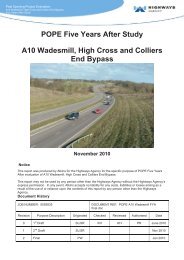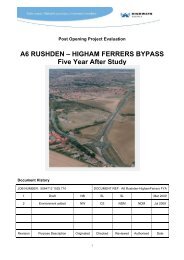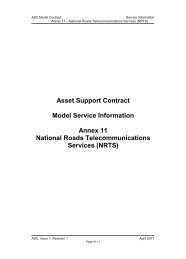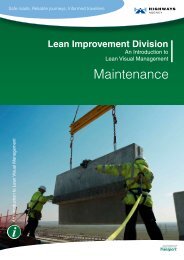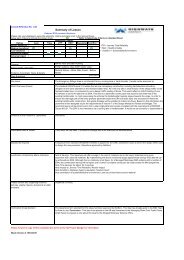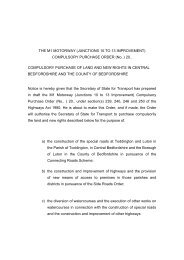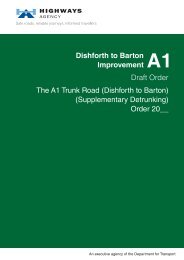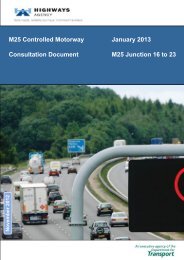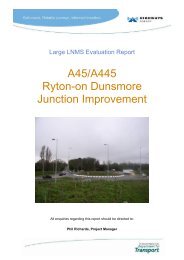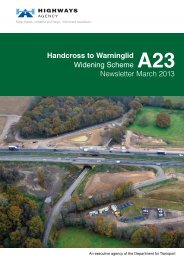MMFD-ERA-030- Final Issue - Highways Agency
MMFD-ERA-030- Final Issue - Highways Agency
MMFD-ERA-030- Final Issue - Highways Agency
Create successful ePaper yourself
Turn your PDF publications into a flip-book with our unique Google optimized e-Paper software.
Managed Motorways – All Lanes RunningEvaluation of the provision of Refuge Areas<strong>MMFD</strong>-<strong>ERA</strong>-<strong>030</strong>- <strong>Final</strong> <strong>Issue</strong>Produced by:Reviewed by:Internally Approvedby:Version:Lucy KinderRyszard Gorell (HCG)Lucy WickhamNo. Date Summary of changesDraft A 31.01.12 Draft for circulation and commentDraft B 12.03.12Client draft for circulation andcommentDraft C 14.05.12 Minor comments from HA<strong>Final</strong> 08.06.12 <strong>Final</strong>Contract Ref: 114/2/1308Task Ref: 499(1308) MOTTProject Sponsor: Max BrownDate: 08/06/2012
CONTENTSExecutive Summary.........................................................................................................31. Purpose ...................................................................................................................72. Background .............................................................................................................83. Supporting Information / Literature Review ...........................................................124. <strong>ERA</strong> spacing and location .....................................................................................135. <strong>ERA</strong> Design...........................................................................................................216. Maintenance Requirements...................................................................................24Appendix A – Literature Review ....................................................................................26
Executive SummaryRefuge Areas are an integral part of the design of a Managed Motorway scheme. Theyhave evolved since their first deployment on the ATM Pilot scheme on the M42. Thelatest design, Managed Motorways All Lane Running (MM-ALR) proposes further‘stretching’ their provision in order to provide an efficient and cost effective solution thatremains able to achieve the required level of safety.It is suggested and evidenced in this document that decreasing the frequency of refugearea spacing will not have a significantly detrimental affect on traffic flow, overall safetylevel or incident numbers. Evidence largely supports the view that the majority of driverswill still be able to find refuge in a genuine emergency, provided that illegal / nonemergencystops in refuge areas are successfully managed. A refuge area is defined inIAN 161 as a place (or facility) where drivers can stop in an emergency. Appropriaterefuge areas are: a motorway service area a hard shoulder on an exit slip/link road a hard shoulder within a junction (lane drop/lane gain only) a bespoke facility, such as an emergency refuge area (<strong>ERA</strong>)It is further recommended and evidenced that the design of bespoke <strong>ERA</strong>s may beadapted / relaxed, so long as the ‘ethos’ associated with their provision remainsconsistent with current arrangements. It concludes that the length of an <strong>ERA</strong> shouldremain the same as that specified in IAN 111/09 [1] for the lower frequency MM-ALRarrangement. It is considered that the width can be specified as 4.0m. This is consistentwith the minimum width allowable in IAN111/09, with a Departure from Standard.Changing this width would remove the need for Departures and is consistent with thefact that no degradation in <strong>ERA</strong> performance has been noted as a result of adoption ofthese departures on implemented schemes. The disassociation of <strong>ERA</strong>s from adjacentgantry locations will minimise the need for costly retaining structures and allow theoptimisation of refuge locations on a scheme.It is expected that there will be less vehicle stoppages due to the permanent removal ofthe Hard Shoulder. However, there will be additional stops in the running lane which willlead to greater risk; this is assessed as being within the bounds of acceptability whencompared against the agreed safety baseline. Control provided through MM-ALRfeatures, will contribute to the mitigation and management of this risk. It is expected thatthe overall risk of the MM-ALR design will be lower than that on dual 3-lane Motorwaywithout MIDAS (the agreed baseline).Capability to create an emergency lane (any lane on the motorway) and management oftraffic through the use of signs and signals to enable access for emergency vehicles ormaintenance workers can be provided. Any planned work will be undertaken usingtemporary traffic management and at reduced mandatory speeds as is currently thecase on managed motorways. The absence of a hard shoulder in the MM-ALR scenariowill make the issues associated with maintenance more challenging and work tosatisfactorily resolve this is currently on-going.499(1308) MOTT 3<strong>MMFD</strong> – Evaluating the Frequency of Emergency Refuge Areas (<strong>ERA</strong>s) – <strong>Final</strong>
The proposed design changes are based on experience of designing and operatingmanaged motorways for over five years. This experience and detailed assessment hasdemonstrated that increasing the spacing between refuge areas is not expected to havea significant detrimental impact on road users. The changes in the design of <strong>ERA</strong>s onManaged Motorway schemes is summarised in the table overleaf:499(1308) MOTT 4<strong>MMFD</strong> – Evaluating the Frequency of Emergency Refuge Areas (<strong>ERA</strong>s) – <strong>Final</strong>
DesignconsiderationM42 ATM Pilot IAN 111 Design IAN 111 Stretch MM-ALR CALR onShorter LinksDriver BehaviourHigh compliance withsignals, due toenforcement and fixed HSCCTV provision –perception of a highlycontrolled environment.High compliance withsignals, due to enforcementand fixed HS CCTVprovision – perception of acontrolled environment.High compliance withsignals, due toenforcement andfixed HS CCTVprovision –perception of acontrolledenvironment.Less infrastructure andenforcement. Perceptionof a controlledenvironment retained asa key design mitigationrequirement.Use of all laneswithout a hardshoulder,therefore driverperception thatstopping is notan acceptableoption.<strong>ERA</strong> Spacing<strong>ERA</strong>s co-located withgantries, nominally at500m spacing<strong>ERA</strong>s co-located withgantries, nominally at 800mspacing<strong>ERA</strong>s co-located withgantries. Nominalspacing potentiallygreater than 1000mSpacing up to 2500mCALR for shortlinks – no <strong>ERA</strong>sspecified.<strong>ERA</strong> DesignLocation /Placement of <strong>ERA</strong><strong>ERA</strong>s co-located withgantries<strong>ERA</strong>s co-located withgantries<strong>ERA</strong>s co-located withgantries<strong>ERA</strong>s placed wheremost economic fordesign / construction +mid linkCALR for shortlinks – no <strong>ERA</strong>sspecified.Number ofEmergency Stops2 Breakdowns (1 <strong>ERA</strong>stop, 1 hard shoulderstop).Data from Monitoringresults.Anticipated similar numberto M42 evidence.Anticipated similarnumber to M42evidence.Anticipated minimum i.e.25% of all stopscurrently occurringAnticipatedminimum i.e.25% of all stopscurrentlyoccurringNumber of ComfortStops60 Comfort stops per dayper 14.395 km (majority in<strong>ERA</strong>s)Data from Monitoringresults.Anticipated similar numberto M42 evidence.Anticipated similarnumber to M42evidence.Minimum comfort stopsanticipated within ALRsection.Minimumcomfort stopswithin CALRsection
DesignconsiderationM42 ATM Pilot IAN 111 Design IAN 111 Stretch MM-ALR CALR onShorter LinksIncident Rate / DistributionMaintenance Style /Location<strong>ERA</strong>s available formaintainers. HS closuresare possible.<strong>ERA</strong>s available formaintainers. HS closuresare possible.<strong>ERA</strong>s available formaintainers. HSclosures are possible.<strong>ERA</strong>s available atnominal 2500m spacing- alternative solutionrequired to facilitate safemaintenance. Potentialuse of rolling roadblocks (RRB) andmaintenance hardstandings (MHS).No <strong>ERA</strong>savailable formaintenance–alternativesolution requiredto facilitate safemaintenance.Potential use ofRRBs and MHS.Journey TimeImpactJourney time benefits dueto homogenisation of trafficby VMSL, and reduction ofcongestion seed pointsJourney time benefits dueto homogenisation of trafficby VMSL, and reduction ofcongestion seed pointsJourney time benefitsdue tohomogenisation oftraffic by VMSL, andreduction ofcongestion seedpointsJourney time benefitsdue to homogenisationof traffic by VMSL, andreduction of congestionseed pointsPermanent hardshoulderrunning,therefore lesscongestion, andimprovedjourney timeSafety with respectto BaselineSafety benefits of 60%approxSafety benefits of 30%Safety benefits of25%Safety benefits of 15%Hard shoulderincidentseliminated,howeverincidents inrunning lanesincreasedcalculated safetybenefit of 5%499(1308) MOTT 6<strong>MMFD</strong> – Evaluating the Frequency of Emergency Refuge Areas (<strong>ERA</strong>s) – <strong>Final</strong>
1. PurposeThis evaluation presents the three key issues regarding refuge areas andparticularly the deployment of bespoke Emergency Refuge Areas (<strong>ERA</strong>s) on theconfiguration of Managed Motorways – All Lanes Running. For the purposes ofthis document it is referred to as MM-ALR.These issues are:The spacing of refuge areasThe design of <strong>ERA</strong>sThe maintenance requirements of the motorway.The evaluation is structured as follows:Section 2 - presents background information on the use of <strong>ERA</strong>s on ManagedMotorways schemes, why aspects of <strong>ERA</strong>s are being evaluated, the safetyrequirements associated with <strong>ERA</strong>s and the design philosophy for MM-ALR.Section 3 - presents supporting information from a literature review which hasbeen used to inform this evaluation.Section 4 – presents an assessment of refuge area spacingSection 5 - presents an assessment of <strong>ERA</strong> design characteristicsSection 6 – describes the maintenance challenges associated with MM-ALR.Section 7 - ReferencesAppendix A – provides details of relevant background information
2. BackgroundThe M42 ATM Pilot scheme was the first deployment of Managed Motorways inthe UK. It featured a high concentration of infrastructure including the provision ofbespoke Emergency Refuge Areas at a nominal spacing of 500m.Monitoring of the M42 scheme post implementation indicated that a variety ofbenefits accrued as a result of the operation of the scheme. These benefitsincluded incident and accident rate and severity improvements as well ascongestion / journey time improvements. As a result, the scheme safetyobjective has been exceeded by a significant margin.Detailed monitoring of hard shoulder and <strong>ERA</strong> activity was undertaken soon afterimplementation of the ATM Pilot and presented in project document reference42690DOC/0056 [2]. This work was based on analysis of CCTV images whichcoincided with a section of the Pilot scheme on which <strong>ERA</strong>s are located at anominal spacing of 800m. This monitoring indicated that a wider spacing of <strong>ERA</strong>sdid not compromise the expected use or usefulness of the <strong>ERA</strong>s.This monitoring gave confidence in the design guidance for Managed Motorways(IAN111/09) which states that ‘<strong>ERA</strong>s form an integral part of the ManagedMotorways - Hard Shoulder Running design and will be spaced between 600mand 1000m inter-junction’. Since the issue of IAN111/09 further work has beenundertaken on the design of Managed Motorways resulting in an updatedconcept referred to as ‘MM-ALR’. This work has also been informed by the formalpublication of the 3 year monitoring results from the M24 ATM Pilot This reviewand analysis has suggested that the level of infrastructure, including theplacement and frequency of <strong>ERA</strong>s may be altered / relaxed without having adetrimental impact on the safe operation of a scheme. The development of theMM-ALR concept was also precipitated by the need to demonstrate value formoney in the current economic climate, an evolving view of the acceptable levelof safety risk and tolerability of risk on a MM scheme. The basic design for MM-ALR is shown in Figure 2.1.499(1308) MOTT 8<strong>MMFD</strong> – Evaluating the Frequency of Emergency Refuge Areas (<strong>ERA</strong>s) – <strong>Final</strong>
Figure 2.1: MM-ALR499(1308) MOTT 9<strong>MMFD</strong> – Evaluating the Frequency of Emergency Refuge Areas (<strong>ERA</strong>s) – <strong>Final</strong>
MM-ALR incorporates refuge areas at less frequent intervals i.e. a greaterspacing, than has been specified previously. A refuge area is defined in IAN 161as a place (or facility) where drivers can stop in an emergency.Appropriate refuge areas are: a motorway service area a hard shoulder on an exit slip/link road a hard shoulder within a junction (lane drop/lane gain only) a bespoke facility, such as an emergency refuge area (<strong>ERA</strong>)MM-ALR also differs from previously designed and implemented MM schemes inthe following respects that are relevant to the frequency, design and use ofrefuge areas: Vehicles will be travelling at a maximum speed of 70mph i.e. in off peaktimes, when the motorway is free from congestion and there will be nostandard restriction of speed to 60mph when Lane 1 is in operation as arunning lane. The hard shoulder will be permanently converted to a running lane, along withthe ability to dynamically control mandatory speed limits. This removes thecomplex operating regime of opening and closing the hard shoulder andgenerates significant capital and operational cost savings. Refuge area will not be co-located adjacent to gantries or cantilever signs;Refuge areas are expected to be up to approximately 2500m apart. There will be areas of the verge where it will be possible for motorists to stoptheir vehicles in cases of emergency breakdowns, when there is no refugearea provided in the vicinity. Where an emergency refuge area is provided, ERTs will also be provided. Refuge areas are to be used for breakdowns and genuine emergencies only.It is assumed that no comfort stops will be taken in refuge areas. Cabinets and other equipment will be placed in the location where optimumbenefit can be gained by maintainers.It should be noted that the MM-ALR design philosophy makes best use of theexisting layout of the road. Refuge areas may either be bespoke facilities (an<strong>ERA</strong>) or converted from an existing facility, for example a wide load bay. Amotorway service area (MSA), the hard shoulder on an exit slip road, or intrajunction,may all be considered to provide a refuge area. Therefore, <strong>ERA</strong>s formpart of a wider strategy of refuge areas providing places of refuge at regularintervals.499(1308) MOTT 10<strong>MMFD</strong> – Evaluating the Frequency of Emergency Refuge Areas (<strong>ERA</strong>s) – <strong>Final</strong>
2.2 Safety RequirementsThe safe operation of MM-ALR is dependant on a number of safetyrequirements, which have already been identified and captured during thedevelopment of the concept. The safety requirements that are relevant to refugeareas are as follows.Winter treatment must include refuge areas.Comprehensive Closed Circuit Television (CCTV) camera coverage (Pan TiltZoom (PTZ)) shall be provided on the carriageway (including refuge areas).Comprehensive is defined as the ability of operators to see up to 95% of thetotal scheme area and be able to interpret the images correctly (It is notedthat it is sometimes impractical to provide 100% CCTV coverage eg: signs orbridges may obscure part of the view. 95% coverage including all areas ofspecial interest would be acceptable.2.3 The selection of a refuge area maximum spacing of 2500m for MM-ALRIn carrying out the review of the features of MM (including the spacing of refugeareas) it is necessary to make a number of assumptions about the MM design.These assumptions are then tested using a systematic approach in order todetermine the likely safety performance of MM-ALR. This systematic approach isbased on the analysis of the hazards that will be impacted by the concept. It isnot true to say that the hazard analysis derives an optimum refuge area spacing;balancing the requirements of safety and value management. It is howevercorrect to say that the safety analysis determines whether a particularcombination of design features will be acceptably safe.Initially, the MM-ALR concept was evaluated based on a design that did not haverefuge areas. This safety evaluation suggested that the design was close toachieving an acceptable level of safety. However, given this result and otherconsiderations such as operability of the concept and reputational considerationsfor the HA, it has now been concluded that refuge areas should form part of thedesign.The selection of an initial assumption of a maximum spacing of 2500m isconsistent with the Highway <strong>Agency</strong>’s Technical Document TD69/07 “Thelocation and layout of Lay-bys and Rest Areas”. This document states that for AllPurpose Trunk Road Dual Carriageways the maximum spacing for lay-bys is2500m. This represented a starting point for the analysis and also enablescomparisons to be made with the safety performance of existing multi-lane All-Purpose Trunk Roads (APTR) [7].499(1308) MOTT 11<strong>MMFD</strong> – Evaluating the Frequency of Emergency Refuge Areas (<strong>ERA</strong>s) – <strong>Final</strong>
3. Supporting Information / Literature ReviewIn moving from the design solution in IAN 111 /09 to MM-ALR, a number ofstudies and reviews have been completed which are relevant to refuge areas andthe frequency of their provision. These progressively support the view that refugeareas can be located at a reduced frequency. These studies are listed below anddescribed in more detail in Appendix A. A detailed assessment of the implicationsof a wider refuge area spacing (i.e. 2500m apart) is described in Section 4.IAN 111 - <strong>ERA</strong>s should be placed between 600 and 1000m inter-junction,and co-located with gantries M42 ATM Review of Safe Haven Lay-by Frequency and Specification –As the distance between <strong>ERA</strong>s is increased, the carriageway blockagerate levels off, indicating that below a certain frequency, however this ischanged, the blockage rate will largely remain stable; i.e. the blockagerate for <strong>ERA</strong>s at 2500m is unlikely to be much higher than that for 1500m.M42 ATM CCTV monitoring – suggested that the underlying assumptionsabout the rate at which vehicles are able to make it to an <strong>ERA</strong> wereconservative, suggesting that the distance between <strong>ERA</strong>s could beextended.Birmingham Box Phase 3 Managed Motorways – The breakdown rate forthe Bromford Viaduct, part of this scheme, is particularly low (well belowthe National Average), indicating that when necessary, or when a locationis deemed undesirable for motorists to stop, it is possible for vehicles tocontinue to a place perceived to be more safe to stop.CALR for Shorter Links [6] – There are currently hard shoulderdiscontinuities on the UK Motorway Network of up to 2000m, with noobvious safety disbenefits.Lay-bys Standard, DMRB Volume 6, Section 3 [4] – It is recommendedthat lay-bys are placed at a distance of 2500m on dual carriageways.499(1308) MOTT 12<strong>MMFD</strong> – Evaluating the Frequency of Emergency Refuge Areas (<strong>ERA</strong>s) – <strong>Final</strong>
4. Refuge area spacing and location4.1 IntroductionAs noted previously, the MM-ALR concept incorporates refuge areas at amaximum spacing of 2500m. When compared with existing managed motorwayschemes, this is a reduced frequency of refuge area provision. However, thisspacing is consistent with lay-by provisions on the all-purpose trunk road (APTR)network.This section supports the view that, utilising a 2500m frequency of refuge areason the MM-ALR Concept is considered to be acceptably safe. This is evidencedby: The good safety performance of existing Managed Motorways schemes, The likelihood of a reduce vehicle stopping rate on MM-ALR (as drivers ofbroken-down vehicles are, to an extent, able to choose where they stop, andthat without a hard shoulder discretionary (illegal stops) are eliminated), The safety performance of 3-lane APTRs (which, although worse than 3 lanemotorways, are comparable). A detailed hazard log based assessment.The following is also considered: Evidence of the safety performance of Managed Motorways schemes The safety performance of roads with similar characteristics to MM-ALR. Implications of providing refuge areas at a spacing at 2500m Overall safety performance of the MM-ALR concept with refuge areas at aspacing at 2500m Impact on carriageway blockages. Other issues including, driver behaviour and cost implications of less frequentrefuge area provision that are not associated with other managed motorwayfeatures such as gantries.4.2 Evidence of the Safety Performance of Managed Motorways schemesThe safety performance of the M42 Managed Motorways (MM) Pilot has beenreported in the document “M42 MM Monitoring and Evaluation three year safetyreview”[3].499(1308) MOTT 13<strong>MMFD</strong> – Evaluating the Frequency of Emergency Refuge Areas (<strong>ERA</strong>s) – <strong>Final</strong>
It reports that there has been a substantial (55.7%) reduction in the number ofPersonal Injury Accidents (PIA) and a reduction in the severity of accidentsduring the first 36 months of MM operation.An analysis within this report indicates that the improvement is not uniformacross all hazards. The report suggests that the frequency of Rear-end ShuntPIAs is reduced by 50%, the frequency of Single Vehicle PIAs is reduced by 80%while the frequency of Side Impact PIAs remains at approximately the samelevel. The Rear-end Shunt PIAs reduction is particularly relevant to this analysis,as it is this type of accident that is likely to result from vehicles stopped in thecarriageway.The key implication from the above is that the MM concept is very safe and thereis considerable scope for a ‘value engineering’ review of MM features. Theseinclude permanent use of the hard shoulder as a running lane and the increasedspacing of refuge areas.4.3 The safety performance of roads with similar characteristics to MM-ALRIn order to inform the likely safety performance of the proposed MM-ALR designwith refuge areas at 2500m intervals, an analysis was undertaken of the accidentand casualty rates on the <strong>Highways</strong> <strong>Agency</strong> road network[7].The analysis concentrated on links between junctions and covered Dual 3-lanemotorways and multi lane All Purpose Trunk Roads (APTR) (i.e with 2 or 3 lanesin each direction). The 3-lane APTRs were considered to be of most relevanceto the MM-ALR concept as they do not have hard shoulders and lay-by spacingsimilar to the MM-ALR concept.The analysis shows that the lowest rates of Fatal and Serious Accidents andCasualties can be found on D3M links. (Rate is measured per vehicle mile). Therates are higher on APTR 3-lane links, and higher still on APTR 2-lane links. Thisis illustrated in the figures below499(1308) MOTT 14<strong>MMFD</strong> – Evaluating the Frequency of Emergency Refuge Areas (<strong>ERA</strong>s) – <strong>Final</strong>
KSI Accident and Injury rates by road typeKSI Accident Rate (2005-2009)KSI Accidents per 10^8 vehicle mile2.001.801.601.401.201.000.800.600.400.200.00D3M APTR - Dual 2 Lane APTR Dual 3-laneRoad TypeSerious AccidentsFatal AccientsKSI Injury Rate (2005-2009)2.50KSI injuries per 10^8 vehicle mile2.001.501.000.500.00D3M APTR - Dual 2 Lane APTR Dual 3-laneRoad TypeSeriously InjuredKilledFrom this it can be seen that the lowest rate of fatal and serious accidents (KSIaccidents) and KSI injuries can be found on D3M links. A Hard Shoulder ispresent on these links. However the rate on APTR Dual 3-lane is only slightlyhigher than that on D3M.In comparison with D3M links, APTR links are characterised by: A four to five fold increase in the frequency of vehicle parked in maincarriageway accidents.499(1308) MOTT 15<strong>MMFD</strong> – Evaluating the Frequency of Emergency Refuge Areas (<strong>ERA</strong>s) – <strong>Final</strong>
An increase in the frequency of accidents involving vehicles leaving thecarriageway No increase in the frequency of fatigue related accidents An increase in frequency of Pedestrian accident No increase in the frequency of Debris related accidents An increase in the frequency of accidents involving a motorcycle.A more detailed analysis has also been undertaken on three sections of roadswhich are known to have three lanes without a hard shoulder or substantial hardstrip. The three specified sections are:- A3 – Stoke Interchange to Stratford Bridge A23 – M23 Junction 11 to Handcross A46 – Junction with A249/B4115 to Junction with A45The implication of the analysis of the accident and casualty data collected fromthe three selected APTR links suggests that 3-lane APTR links are capable ofperforming at a level of safety comparable with D3M links with similar geometry.There are differences in the type of accident and casualties on these roads. It isalso noted that Vehicles parked in the carriageway accidents are higher.4.4 Implications of providing Refuge Areas at a maximum spacing of 2500mAppendix A of this document presents a number of items of research andevidence that are relevant to the provision of refuge areas at a spacing of 2500madjacent to four permanent running lanes. The main points to note are as follows:The vehicle breakdown rate varies considerably depending upon location. It isparticularly important to note the evidence from the Bromford Viaductsupports the view that many drivers are able to nurse a broken down vehicleup to a few Km distance before stopping (in carriageway locations wheredrivers perhaps perceive themselves to be vulnerable). On dual 3-lane motorways, discretionary stops (comfort stops and vehiclechecks on the hard shoulder, i.e. illegal stops) outnumber breakdowns bybetween 8 and 10 times.As they are typically 3 to 5 minutes long, typically only 50% of the timevehicles are stopped on the hard shoulder are as a result of vehiclebreakdowns. The implication of converting the hard shoulder to a running laneis that the majority of stops that currently occur on the hard shoulder will be499(1308) MOTT 16<strong>MMFD</strong> – Evaluating the Frequency of Emergency Refuge Areas (<strong>ERA</strong>s) – <strong>Final</strong>
eliminated and the exposure to risk on the Hard Shoulder is reduced by 50%(thus reducing risk by 50%).Drawing together the data from the various sources presented in Appendix A, it ispossible to determine the relative vehicle stopping rates for a standard Dual3lane motorway (D3M) and MM-ALR based on the following assumptions.1. The two-way flow is of the order of 130,000 vehicles per day (0.13 millionvehicles - typical of the values that would warrant use of an extra lane atpeak.)2. That the breakdown rate is 12 per million vehicle mile3. That breakdowns are typically of one hour duration and that breakdownsaccount for 50% of time exposure (if discretionary stops are still present)4. That discretionary stoppages (comfort stops, vehicle checks ) happen 9 timesmore often than breakdowns5. For the MM-ALR concept there will be no discretionary stops on thecarriageway6. For MM-ALR that there will be minimal discretionary stops in the refuge areas(However given the experience of the M42 Pilot, mitigation maybe required toprevent the use of the refuge area for comfort stops: eg: more forcefulsignage, penalties for improper use etc). This assumption should be testedthrough a sensitivity analysis in order to determine the level of confidence in itand the levels of compliance that would lead to concern.7. That in a breakdown emergency 50% of drivers will be able to get theirvehicles to a place of safety (takes into account previous work on proportionof broken-down vehicles that can be driven a short distance).Using the above assumptions, for D3M: The number of breakdowns per day = 12*0.13 = 1.56 per day per motorwaymile (i.e. 0.79 per day per carriageway) Time that broken-down vehicle is on Hard Shoulder = 1.56 hours per day permotorway mile The number of discretionary stops is = 12*0.13*9 = 14.0 per day permotorway mile Total time stoppages on Hard Shoulder per day = 3.12 hours per day permotorway mile499(1308) MOTT 17<strong>MMFD</strong> – Evaluating the Frequency of Emergency Refuge Areas (<strong>ERA</strong>s) – <strong>Final</strong>
For MM-ALR:The number of breakdowns per day = 12*0.13 = 1.56 per day per motorwaymile (i.e. 0.79 per carriageway)However if it is assumed that 50% of drivers will be able to get their vehiclesto a place of safety then the rate is 0.79 per day per motorway mile (i.e. 0.4per carriageway)Time that broken-down vehicle is on the carriageway per day = 0.79 hoursper day per motorway mile.Assumption: Minimal discretionary stops in refuge areaIn summary:For dual 3-lane motorways, the total vehicle stoppage time (on the hardshoulder) is estimated to be 3.12 hours per day per motorway mile.For the MM-ALR concept, the total vehicle stoppage time (outside refugeareas) is estimated to be 0.79 hours per day per motorway mile. This is basedon discretionary stops being eliminated and 50% of broken-down vehiclestopping in a refuge area.With regard to the last point, these vehicles (i.e. ones which the driver has beenunable to reach a refuge area) would either have to stop on the carriageway orthe verge. During the peak, the traffic would be managed and as such there islittle difference to existing MM schemes (which, as noted before, already have agood safety record).There will however, be an increased exposure to potential risk off-peak whichwill, to an extent, be mitigated through CCTV surveillance and the setting ofsignals and mandatory speed limits, once the stopped vehicle is identified.4.5 Overall safety performance of the MM-ALR concept with Refuge Areas at aspacing of 2500mThe main points to be drawn from the previous sections are that: Multi-lane roads without a hard shoulder but with lay-bys can perform at asimilar safety level to Dual 3-lane motorways. These roads are similar to theMM concept but without control. Evidence from the M42 ATM pilot indicates that a substantial reduction inaccidents and casualties can be achieved where mitigation is added to createa ‘controlled environment’.499(1308) MOTT 18<strong>MMFD</strong> – Evaluating the Frequency of Emergency Refuge Areas (<strong>ERA</strong>s) – <strong>Final</strong>
A hazard based assessment of the performance of the MM-ALR concept hasbeen undertaken. The results suggest that the concept is able to operate with alevel of safety that is comparable or better than a standard dual 3 –lanemotorway without MIDAS.This is because the substantial benefits obtained from appropriate control (Asevidenced from the M42 ATM pilot) out-weight the elevated risk (as evidencedfrom the APTR study).4.6 Carriageway blockagesConsideration of the above literature review, and looking at the mean number ofblockages expected, if the <strong>ERA</strong> spacing was to be increased, there would not bea commensurate increase in the number of blockages. This is due to thelikelihood that vehicles can travel under their own power with 50% of vehiclebreakdowns likely to be able to travel a mile to reach a refuge area. However, ifrefuge areas were to be removed completely, it is likely that the number of livelane blockages will commensurately increase. Note that this calculation is basedon a prevailing flat topography and schemes will need to assess the impact ofextensive sectiond with gradients > 2%.4.7 Other issuesThis sub-section covers other issues related to the reduced frequency of refugeareas and the decision to disassociate refuge areas with other MM features suchas gantries.4.7.1 Driver behaviourIncreasing the spacing of refuge areas is anticipated to have a number of effectson driver behaviour.The use of refuge areas for emergency purposes only will be encouraged byappropriate signing and driver education messages. The objective therefore isthat their reduced frequency will lead them to be used for illegal / inappropriatepurposes more sparingly. Secondly, since they are more scarce, they becomeless prominent within the scheme. In an emergency, if a driver misses a refugearea that they could have used there is an increased chance of a blockage onthe carriageway.For the above reasons, and since refuge areas are now not expected to be colocatedwith other MM features such as gantries, it becomes more important toalert the general public to their location and use both in advance (througheducation eg: literature, publications and web-based information) and within thescheme through the use of advance signing (to assist drivers in their location)and signing to emphasis that their use is for an emergency only.499(1308) MOTT 19<strong>MMFD</strong> – Evaluating the Frequency of Emergency Refuge Areas (<strong>ERA</strong>s) – <strong>Final</strong>
4.7.2 CostIn order to deter road users from crossing the carriageway, it is considered thatthe requirement to place refuge areas opposite each other should be retained. Itmay be possible to introduce a degree of flexibility around this, within certainlongitudinal parameters without loosing the essence of the ethos. It remains arequirement to provide emergency roadside telephones at refuge areas andthese ERTs will also be required to be placed opposite each other for the samefundamental reason – to deter carriageway crossings by road users.It is thought that the disassociation of refuge areas from gantries will have apositive cost impact. Currently costly designs are necessitated by the mandatoryguidance for refuge areas to be placed generally downstream of a gantry(geotechnical and geometric constraints etc can result in significant retainingstructures being required). This suggests that the placement of refuge areas iscurrently according to the location from which the greatest operational benefitfrom the gantry will be realised. By rationalising refuge areas and locating thesewhere the lowest cost solution is legitimised, savings can be made on asignificant item of capital infrastructure.499(1308) MOTT 20<strong>MMFD</strong> – Evaluating the Frequency of Emergency Refuge Areas (<strong>ERA</strong>s) – <strong>Final</strong>
5. <strong>ERA</strong> DesignThere is a relevant public perception of refuge areas on Managed Motorwaysschemes (<strong>ERA</strong>s) that has been developed over time. It is therefore considerednot to be advantageous to fundamentally change their appearance. It issuggested that the baseline for consideration of the refuge area design be drawnfrom information contained in the Highway Code, public consultations for MMschemes and other relevant Standards. The information reproduced below iscontained within the Highway Code:“You MUST NOT use the hard shoulder for overtaking. In areas where anActive Traffic Management (ATM) Scheme is in force, the hard shouldermay be used as a running lane. You will know when you can use thisbecause a speed limit sign will be shown above all open lanes, includingthe hard shoulder. A red cross or blank sign above the hard shouldermeans that you MUST NOT drive on the hard shoulder except in anemergency or breakdown. Emergency refuge areas have also been builtinto these areas for use in cases of emergency or breakdown.”Further information about Emergency Refuge Areas 1 is provided in a number ofother documents. The increased spacing of refuge areas is likely to lead to anincrease in the frequency of their individual use.The presence of an ERT in an emergency refuge area is also considered to be afundamental provision. It is however worthy of note that in the simulationundertaken of the MM-ALR concept at TRL in 2011,ERTs were not included andno participants commented on their absence from the simulation.Safety analysis work clearly demonstrates the risks associated with safe entryand exit from a refuge area. Therefore the location of a refuge area must seek tomaximise sightlines and visibility and not compromise access / egress to them.The provision of CCTV can assist the RCC operators in the management of<strong>ERA</strong>s through general surveillance and active intervention when observed orconsidered necessary.It is considered that the length of refuge area (100m) should be preserved, asprescribed in IAN 111. This was based on a TD 69/07 Type B layout, with entry /exit taper lengths reversed to maximise the length of acceleration of a vehicle inre-joining the motorway. The length and operation of the refuge area design wasrigorously tested in a simulation at the test track at the Fire Service College inMoreton-in-Marsh and in practice on the schemes implemented to date.It has met with the acceptance and ‘approval’ of stakeholders and the length canaccommodate all the parties involved in vehicle remediation / recovery (includingHGVs). A similar argument follows for the width of refuge areas.1Highway Code Supplementary Notes - Addendum499(1308) MOTT 21<strong>MMFD</strong> – Evaluating the Frequency of Emergency Refuge Areas (<strong>ERA</strong>s) – <strong>Final</strong>
IAN 111/09 prescribes a width of 4.6m with an allowable departure to a reducedwidth of 4.0m. In practice the 4.0m width has been accepted as an allowabledeparture on a number of schemes and no degradation in performance has beenreported or observed. It is therefore considered reasonable to prescribe a widthof 4.0m as an acceptable relaxation in standard for the MM-ALR design, whichmust be recorded in the Design Strategy Report (DSR). This width is greater thanthe width of a standard hard shoulder provision and will still contribute to theenhanced safety of operatives and motorists whilst within a refuge area. In areaswhere the road gradient is > 2% and the % of HGVs is higher than average, arisk based safety review is recommended given that the speed under MM-ALR islikely to be 70mph.The below table summarises the key points made in this section, with regards tothe significant areas that would be impacted by any refuge area redesign.ImplicationLegalSafetyEmergencyServicesaccessRecoveryOperatorsDriverBehaviourResult of re-design of Refuge AreaNo legal implications have currently been identified pertinent to theVariable Speed Limit Regulations. This statement is made on the basisthat the ethos of the refuge area provision will remain unchanged andthe information currently contained within the Highway Code will remainvalid and applicable to the MM-ALR design. The exception to this,which may result in the need to review the wording in the HighwayCode, is inclusion of the sentence which reads ‘Features includesensors to alert the control office when a vehicle has entered’. Inclusionof <strong>ERA</strong> loops is not included within the MM-ALR concept. Exclusion ofthis feature would have no bearing or impact on a driver’s perception oruse of a refuge area facility.DfT legal advice is to be sought regarding the status of <strong>ERA</strong>s and anyrelated requirements for Statutory Instruments on MM-ALR schemesShortening of refuge areas presents potential safety issues regardingthe exit and entry of vehicles.Emergency services vehicles are typically longer than the majority ofvehicles using the motorways, hence if refuge areas were to beshortened then this could prove to be problematic for the safe entry andexit of emergency services. It is unlikely however that, in the event ofan incident, emergency services would use refuge areas, since anappropriate lane closure would be implemented.Refuge areas must remain wide enough and long enough to enablerecovery operators to assist vehicles, so the refuge area can be clearedas quickly as possible. If recovery time is compromised, this couldaffect the blockage rate on the mainline, which is undesirable.Changing the design of refuge areas significantly could result inconfusion for motorists seeking a safe place of refuge in the event of abreakdown or emergency. This must be tempered with appropriatedirectional and information signing to guide motorists where to stop insuch a situation. The design should be reinforced, and publicinformation disseminated to deter motorists from stopping within refugeareas for comfort breaks.499(1308) MOTT 22<strong>MMFD</strong> – Evaluating the Frequency of Emergency Refuge Areas (<strong>ERA</strong>s) – <strong>Final</strong>
The working assumption is that refuge areas will be disassociated from gantries(see section 4.7). This allows placement to optimise their location and maximiseStopping Sight Distances (SSDs), which will assist in facilitating the safe exit andentry of vehicles and use by vehicle recovery organisations and the EmergencyServices.It is suggested that the inclusion of refuge area technology e.g. CCTV and loopsis assessed on a case by case basis, according to SSDs and other infrastructurein the vicinity. Refuge area loops are considered less important, provided thatprovision is made (eg: a fixed sign stating that motorists should contact the RCCvia ERT prior to refuge area exit) to facilitate effective mitigation of the hazardsassociated with the exit from a refuge area. Specific refuge area CCTV camerasare also no longer specified as a requirement. Comprehensive CCTV PTZcoverage of the carriageway, including coverage of refuge areas (except MSAs),will however be included. Provision of CCTV images relies on an operator or anautomated system to react and respond in cases where a need is identified. RCCoperators do not and will not be monitoring these CCTV images on a permanentbasis. The facility does exist to enable the images to be viewed whencarriageway conditions alert an operator to a potential intervention requirement.499(1308) MOTT 23<strong>MMFD</strong> – Evaluating the Frequency of Emergency Refuge Areas (<strong>ERA</strong>s) – <strong>Final</strong>
6. Maintenance RequirementsThe aspiration of the <strong>Highways</strong> <strong>Agency</strong> is to take forward initiatives to removethe need for workers to be on the live carriageway (aiming for zero). Designersshould be cognisant of this and seek to have a positive influence on this goal intheir scheme design activities and processes.As part of the MM-ALR design, there is an overall reduction in infrastructure ofaround 50% when compared to an IAN111 design. This will reduce therequirement for maintenance activities, although work undertaken to assess theimpact of maintenance does indicate a greater requirement for temporary trafficmanagement activities. This is primarily due to the deletion of the hard shoulder,which has been used extensively as a platform from which to set out andundertake maintenance activities. To minimise the impact of lane closures onnetwork performance, the majority of maintenance is expected to be undertakenoutside peak periods and will mainly be restricted to night time and weekends. Itis currently anticipated that without suitable mitigation, the overall risk tomaintenance workers will be increased. There is a significant amount of workbeing undertaken within the MM-ALR maintenance workstream to assess andquantify this and to identify suitable and sufficient mitigation to ensure that risksto maintenance workers are managed successfully to be ‘as low as reasonablypracticable’. This is being achieved through consideration of the elimination andreduction of maintenance activities where practicable.All maintenance activities within a MM-ALR scheme must be carried out in a safemanner and are generally expected to be undertaken from either a designatedarea for maintenance or from a lane closure under traffic management. Inexceptional circumstances, maintenance hard standings (MHS) may beconsidered on MM-ALR schemes, where sufficient evidence of their benefits(operational, safety and cost) can be demonstrated.499(1308) MOTT 24<strong>MMFD</strong> – Evaluating the Frequency of Emergency Refuge Areas (<strong>ERA</strong>s) – <strong>Final</strong>
7. References[1] Interim Advice Note 111/09, Managed Motorway Implementation Guidance, HardShoulder Running[2] M42 ATM Pilot, ATM safety monitoring: First set of 4-lane MVSL results[3] M42 MM Monitoring and Evaluation, Three Year Safety Review, HCG, January 2011[4] DMRB TD 69/07 The Location and Layout of Lay-Bys and Rest Areas[5] Review of Safe Haven Lay-by Frequency and Specification 42690/WP/0059[6] Evaluating Controlled All Lane Running (CALR) as a design solution for shorter ManagedMotorways[7] All-Purpose Trunk Roads (APTR)/Dual 3-lane Motorway (D3M) Analysis and HazardAssessment, 1039092/ATA/035
Appendix A – Literature ReviewThis appendix contains information about a number of studies that are relevant to thisevaluation, particularly in terms of the discussion of refuge area spacing presented inSection 4. These papers consider in particular, two parameters that are relevant torefuge area spacing: The frequency of breakdowns and how long a vehicle can travelbefore stopping following a breakdown.A1 Interim Advice Note 111/09The passage below has been extracted from IAN 111/09. It is contained within a‘black box’; indicating that this is mandatory and must be adhered to whendesigning IAN 111 compliant MM schemes. It describes the initial design andspacing of <strong>ERA</strong> for use on Schemes post the M42 ATM Pilot.“<strong>ERA</strong>s form an integral part of the MM-HSR design and will be spaced between600m and 1000m inter-junction (i.e. between junctions). The average frequencymust be no greater than 800m.They are to be co-located with gantries and located downstream of the gantry(See Appendix D Drawing 005). This arrangement is to enable drivers toassociate gantries with an <strong>ERA</strong> beyond it. It also enables signs for the <strong>ERA</strong>(“Emergency Refuge Area - SOS”) to be mounted on the gantry leg (SeeAppendix D Drawing 007) <strong>ERA</strong> signs will need to be authorised by the NetServSafe Road Design Team.If local conditions (topology, SSD) dictate that it is impractical to locate the <strong>ERA</strong>downstream of the gantry, the <strong>ERA</strong> may be located upstream of the gantry (SeeAppendix C Drawing 006). Each <strong>ERA</strong> will have an ERT and the vehicle restraintsystem provided at the <strong>ERA</strong> will have a gap to allow access to the ERT andadjacent equipment such as the CEC.” 2A2Safe Haven Lay-By Frequency and Specification – Oscar FaberThis report calculated the number of blockages caused by broken down vehiclesin the carriageway (i.e. those that could not move to an area of safety), thatwould consequently cause disruption to the traffic flows.The formula for the number of blockages is based around the following threefindings / assumptions: Up to half of breakdowns are able to travel under their own power for at leastone mile Up to 25% of breakdowns are able to enter a lay-by unpowered2IAN 111/09 Section 10
Up to 25% of breakdowns are unable to enter a lay-by and block thecarriageway.The paper noted the following with regard to evidence from the network:“up to 50% of drivers in breaking down vehicles can travel under power for atleast a mile, then we may assume that 50% of breakdowns will travel to thenearest safe haven or exit in an ATM scheme.”The underlying analysis from this paper was used to inform the paper describedbelow.A3 M42 ATM Review of ‘Safe Haven Lay-by Frequency and Specification’ –Cambridge ConsultantsThis document considered the implications of changing the frequency of <strong>ERA</strong>s.The analysis was based on the Operational Regime of the M42 ATM Pilot.Specifically, it reviewed the regime where the hard shoulder is open to traffic andtravelling with a Variable Mandatory Speed Limit (VMSL) of 60mph.Table 1: Results of applying 'Blockages' model to a variety of <strong>ERA</strong>frequencies at 60mph<strong>ERA</strong>Frequency (m)Proportion of vehiclesnot reaching <strong>ERA</strong>Peak period blockagesper km per month500 30.6% 3.49600 33.9% 3.86700 36.2% 4.12800 37.9% 4.32900 39.2% 4.471000 40.3% 4.601100 41.2% 4.701200 41.9% 4.78The results from this model suggested that as the refuge area frequencyincreases, the number of blockages tends towards a limit. This is due to theability of a vehicle to coast a certain distance at a specific speed,499(1308) MOTT 27<strong>MMFD</strong> – Evaluating the Frequency of Emergency Refuge Areas (<strong>ERA</strong>s) – <strong>Final</strong>
Proportion of vehicles not reaching <strong>ERA</strong> vs <strong>ERA</strong> FrequencyProportion of vehicles not reaching <strong>ERA</strong>43.00%41.00%39.00%37.00%35.00%33.00%31.00%29.00%27.00%Proportion ofvehicles notreaching<strong>ERA</strong>25.00%200 400 600 800 1000 1200 1400<strong>ERA</strong> Frequency (m)Figure 1: Graph of Proportion of vehicles not reaching and <strong>ERA</strong> vs <strong>ERA</strong>FrequencyA4M42 ATM CCTV monitoring<strong>ERA</strong> spacing on Managed Motorways (2009 - unpublished)This report analysed CCTV footage of <strong>ERA</strong> and hard shoulder activity for asection of the M42 ATM Pilot where the spacing is approximately 800m.The main conclusions to be drawn from this analysis are a follows:There is good evidence that the breakdown rate happening on the M42 ATMpilot is much less than that used in the model developed in the Oscar Faberreport (reference A2 above). Analysis carried out for Through JunctionRunning also suggests that the frequency of breakdowns is much less thanexpected.There is some evidence supporting the view that approximately 35% ofbreaking down vehicles will not be able to make it to an <strong>ERA</strong>. However, itseems that this rate could apply to <strong>ERA</strong> spacings that are closer to 800m thanthe 500m used in the model.The combination of the above two bullet points suggests that blockagefrequencies for <strong>ERA</strong>s at 800m spacing will be comparable or lower than thoseoriginally modelled for <strong>ERA</strong> spacings of 500m. The overall risk is thereforelikely to be comparable to that that was originally used in the Safety Case forthe ATM Pilot.499(1308) MOTT 28<strong>MMFD</strong> – Evaluating the Frequency of Emergency Refuge Areas (<strong>ERA</strong>s) – <strong>Final</strong>
A5Evaluating Controlled All Lane Running (CALR) as a design solution forshorter Managed Motorways linksThis paper, issued by the <strong>Highways</strong> <strong>Agency</strong> in 2010, details the suitability of linklengths for the application of CALR (Controlled All Lane Running) on Englishmotorways. It was noted that this intervention is not new and at severallocations, due to geometrical constraints, hard shoulder discontinuities fordistances up to 2000m are already in existence (eg: on the M48 Severn Bridgewhere only a hard strip is present). Other locations of hard shoulderdiscontinuities of 600m and 800m include the stretch of motorway betweenJunction 7 and 8 of the M6, and in the proximity of Junction 4 on the M5,respectively. The paper concludes that the expected increase in risk whendeploying CALR over short sections is increased by 2-5% where no additionalmitigation is introduced.A6Birmingham Box Phase 3 Managed Motorway - M6 Bromford Viaduct (J5 toJ6) Breakdown Statistical Analysis NoteThis report details the breakdown rates experienced on the stretch of motorwaybetween J5 and 6, known as the Bromford Viaduct.Table 2: The number of breakdowns per day for Bromford works versus thebaselineData SourceBreakdowns perDayLive LaneStops Only0.87 1.03 3.50 Bromford Hard ShoulderWorks (2008) aRAC Breakdowns onBromford (2008) a,bBromford Breakdowns C&C 1.53 Logs (2008) a,cNationalAverageRoadworks (2007) aHardShouldera M6 Bromford Breakdown Analysis Note (total over AM and PM peaks –8hrs)b Using adjusted figuresc Total over 24hrs, although the majority are observed to be during AM andPM peaks499(1308) MOTT 29<strong>MMFD</strong> – Evaluating the Frequency of Emergency Refuge Areas (<strong>ERA</strong>s) – <strong>Final</strong>
Table 3: Evidence from Other RoadworksAll Purpose Trunk RoadsBreakdowns per DayM25 J2-30 a 0.87Light Vehicle Breakdown Rate b 1.03Heavy vehicle breakdown Rate b 1.53abDartford recovery statistics (no hard shoulder available)Cole and Evans “Incidents and recover procedures in major roadworks”Analysis carried out for Bromford viaduct to determine number of breakdownsusing different sources of data. This has been scaled as indicated to obtain a rateper million vehicle mile.Data SourceBreakdowns per day AM and PMpeaks (8 hrs)Bromford Roadworks (2008) - live lane stopped 0.87M4 J1 to J2 Elevated section 0.76Bromford breakdowns C&C logs (2008)** 1.53M42 HSR60 Safety Monitoring (2008) 2.22RAC Breakdowns on Bromford (2008) - corrected 1.03A38M RAC Stopping Rates - corrected 0.99BBMM Phase 2 BDV Recovery (2010) 2.85National Average Roadworks (2007) 3.50Length in miles 3.75AADT (million vehicles) 0.11Proportion of AADT flow during peak (inferred 0.55from flow data)Vehicle flow Bromford during peak (millionvehicle mile) 0.23Data SourceBreakdowns per million vehiclemileBromford Roadworks (2008) - live lane stopped 3.83M4 J1 to J2 Elevated section 3.35Bromford breakdowns C&C logs (2008)** 6.74M42 HSR60 Safety Monitoring (2008) 9.79RAC Breakdowns on Bromford (2008) - corrected 4.54A38M RAC Stopping Rates - corrected 4.36BBMM Phase 2 BDV Recovery (2010) 12.56National Average Roadworks (2007) 15.43Table 4: Analysis of breakdown rates499(1308) MOTT 30<strong>MMFD</strong> – Evaluating the Frequency of Emergency Refuge Areas (<strong>ERA</strong>s) – <strong>Final</strong>
The relevance sources of data suggest a breakdown rate significantly below thenational average.This indicates that location can influence the breakdown rate, according towhether this is seen as a desirable place to stop by the public. To summarise:The vehicle breakdown rate varies considerably depending upon locationUsing the summation of all the data the vehicle breakdown rate is likely to bebetween 4 and 15 per million per vehicle mile. But it is still likely that it is at thehigher end of the range. This document assumes that it is 12 per million vehicle mile.On D3, discretionary stops (comfort stops and vehicle checks on the hard shoulder)outnumber breakdowns by between 8 and 10 times. They are typically 3 to 5 minuteslong50% of the time vehicles are stopped on the hard shoulder are as a result of vehiclebreakdowns.A7Accidents Alongside High Speed Dual Carriageways – Transport ResearchLaboratory (TRL)This report investigated accident rates and stopping rates on dual carriagewayroads and on the hard shoulder of motorways.This report concluded that most stops on the Hard shoulder were discretionary,but 50% of the time was spent by broken-down vehicles, which means that 50%of exposure could, in theory, be avoided if these discretionary stops could beavoided. There was a clustering of broken-down vehicles around emergencyphones suggesting that many drivers were capable of ‘choosing’ in a limited waywhere to break-down.Distribution of vehicle stops did not appear to be greatly influenced by crosssection,except that elevated sections and bridge parapets tended to be avoided.Other key finding are:On D3, discretionary stops (comfort stops and vehicle checks on the hard shoulder)outnumber breakdowns by between 8 and 10 times. They are typically 3 to 5 minuteslong50% of the time vehicles are stopped on the hard shoulder are as a result of vehiclebreakdowns.A8 Lay-Bys Standard, DMRB Volume 6 Section 3, updated in 2007This guidance recommends that lay-bys are placed at a distance of 2500m ondual carriageways for all Annual Average Daily Traffic (AADT) flows, and at a499(1308) MOTT 31<strong>MMFD</strong> – Evaluating the Frequency of Emergency Refuge Areas (<strong>ERA</strong>s) – <strong>Final</strong>
spacing of between 2000m and 5000m on single carriageways for high AADTflows.499(1308) MOTT 32<strong>MMFD</strong> – Evaluating the Frequency of Emergency Refuge Areas (<strong>ERA</strong>s) – <strong>Final</strong>



